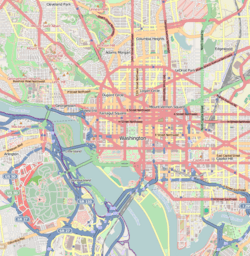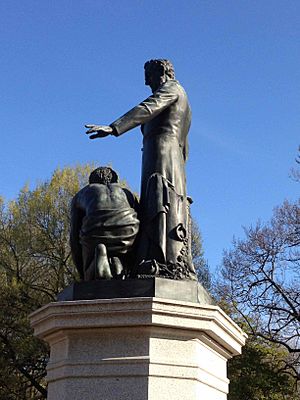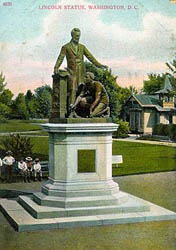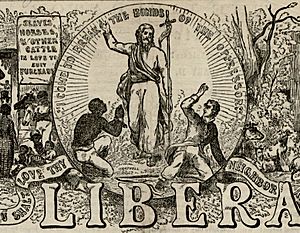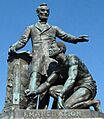Emancipation Memorial facts for kids
Quick facts for kids Emancipation Memorial |
|
|---|---|
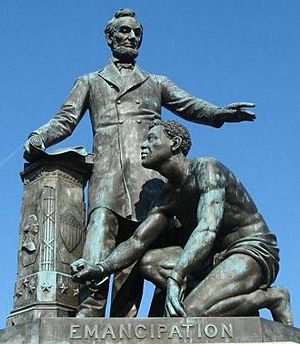 |
|
| Artist | Thomas Ball |
| Year | 1876 |
| Type | Bronze |
| Location | Lincoln Park (Washington D.C.), United States |
| Owner | National Park Service |
|
Emancipation Memorial
|
|
|
U.S. Historic district
Contributing property |
|
| Location | Washington, D.C. |
|---|---|
| Part of | Civil War Monuments in Washington, DC. |
| NRHP reference No. | 78000257 |
| Added to NRHP | September 20, 1978 |
The Emancipation Memorial is a special monument in Lincoln Park in Washington, D.C.. It is also known as the Freedman's Memorial or the Emancipation Group. Before 1922, some people even called it the "Lincoln Memorial."
This statue was designed by Thomas Ball and put up in 1876. It shows Abraham Lincoln, who was president during the American Civil War. He is holding a paper called the Emancipation Proclamation. This paper declared many enslaved people free.
Next to Lincoln is a man who used to be enslaved. He is shown on one knee, getting ready to stand up. He has a strong, clenched fist and broken chains near Lincoln's feet. This man's image was based on a real person named Archer Alexander.
What's really interesting is that the money for this statue came from people who had been enslaved themselves. The statue first faced west, towards the U.S. Capitol. But in 1974, it was turned to face east. This was done so it could look towards the new Mary McLeod Bethune Memorial.
This monument is an important part of the Civil War Monuments in Washington, D.C. It is listed on the National Register of Historic Places.
Contents
How the Monument Was Funded
The idea to raise money for this monument started with a woman named Charlotte Scott. She was a former enslaved person from Virginia. She gave $5, which was her first money earned after gaining freedom. She wanted to honor President Lincoln.
A group called the Western Sanitary Commission joined the effort. This group helped people during the war. They raised about $20,000 and then aimed for $50,000.
The National Park Service says that only formerly enslaved people paid for this monument. They collected money mainly from African American soldiers who fought in the Union Army. This made the monument very special. It was the only one that asked for money only from those who had directly benefited from Lincoln's act of freedom.
During this time, there were many political changes after the war. A group called the Colored People's Educational Monument Association wanted the monument to be a school. They believed it should help freed people learn and improve their lives.
However, Frederick Douglass, a famous writer and speaker, disagreed. He thought that building a school was not the same as remembering Lincoln.
Designing and Building the Statue
Another artist, Harriet Hosmer, suggested a much bigger monument. Her design showed Lincoln on a tall pillar. Around him would be smaller pillars with Black Civil War soldiers and other figures. But her idea was too expensive.
Thomas Ball was already a well-known artist. After Lincoln was killed in 1865, Ball created a smaller version of this statue. When his design was chosen, it was made much larger, about nine feet tall. This became the "Emancipation" group in Lincoln Park in 1876.
In the final design, the formerly enslaved man does not wear a "liberty cap." Instead, he is bare-headed with short, curly hair. His face was changed to look like Archer Alexander. Archer Alexander was a real person who had been enslaved, and his life story was very popular.
In the statue, Lincoln holds the Emancipation Proclamation in his right hand. This document rests on a stand with symbols of America. These symbols include George Washington's profile, the fasces (a symbol of the U.S. republic), and a shield with the stars and stripes. Behind the two figures is a whipping post, which was used to punish enslaved people. A vine grows around the post and a chain ring.
The monument was made in Munich, Germany, in 1875. It was then shipped to Washington the next year. The U.S. Congress accepted the statue as a gift from "colored citizens of the United States." They also provided $3,000 for the base of the statue. The statue was placed in Lincoln Park, where it still stands today.
A special plaque on the monument says:
This monument was erected by the Western Sanitary Commission of Saint Louis Mo: With funds contributed solely by emancipated citizens of the United States declared free by his proclamation January 1 A.D. 1863. The first contribution of five dollars was made by Charlotte Scott. A freedwoman of Virginia being her first earnings in freedom and consecrated by her suggestion and request on the day she heard of President Lincoln's death to build a monument to his memory
The Dedication Ceremony
The monument was officially dedicated on April 14, 1876. Frederick Douglass gave the main speech. President Ulysses S. Grant was also there.
Douglass explained that Lincoln's story was not simple. He said that Lincoln was "a white man" with his own interests and ideas. Douglass pointed out that Lincoln cared more about keeping the country together than freeing all enslaved people. Lincoln himself had said he would save the Union "without freeing any slave" if he could.
Douglass also noted that Lincoln once blamed African Americans for the war. In 1862, Lincoln told Black leaders that "But for your presence amongst us, there would be no war." Douglass also had concerns about how Lincoln treated African Americans who wanted to fight in the war.
However, in the end, Douglass praised Lincoln for what he achieved. He said it was enough that Lincoln led a great movement and truly supported it.
After his speech, Frederick Douglass wrote a letter to a newspaper. It was published a few days later. In his letter, Douglass criticized the statue's design. He felt that the park needed more respectful monuments of free Black people. Douglass wrote that the man in the statue, "though rising, is still on his knees and nude." He wanted to see a monument showing a Black person "erect on his feet like a man."
Criticism of the Monument
The monument has been criticized because it doesn't fully show how African Americans helped free themselves. Even though formerly enslaved people paid for it, a white artist created the original design. Another idea, showing Lincoln with Black Union soldiers, was turned down because it cost too much.
Historian Kirk Savage said that Frederick Douglass felt the statue "showed the Negro on his knees when a more manly attitude would have been indicative of freedom."
On June 23, 2020, a representative from Washington, D.C., Eleanor Holmes Norton, said she would try to pass a law to remove the memorial. On the same day, people protesting at the site said they would take down the statue themselves. After this, a fence was put around the memorial to protect it.
Other Versions of the Statue
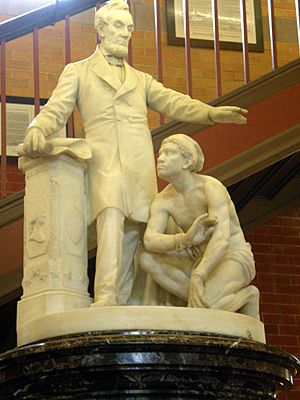
In 1879, a man named Moses Kimball gave a copy of the statue to Boston. It was placed in Park Square. This statue was removed on December 29, 2020. News articles explained that the copy was put in Boston because the artist, Thomas Ball, lived there.
Architect Edward Francis Searles bought an early, smaller version of the statue from Ball. He brought it to Methuen, Massachusetts. It is now in the Town Hall atrium there.
The Chazen Museum of Art at the University of Wisconsin–Madison also has a version of the statue. It is made of white marble and was given to the museum in 1976.
Images for kids
See also
 In Spanish: Monumento conmemorativo a la emancipación para niños
In Spanish: Monumento conmemorativo a la emancipación para niños


